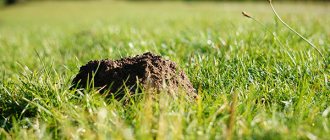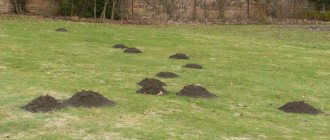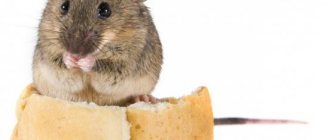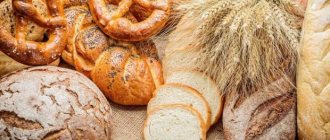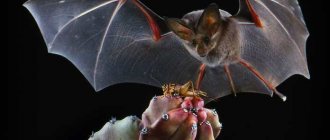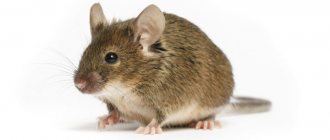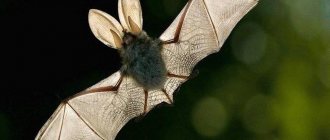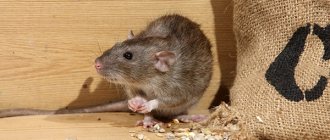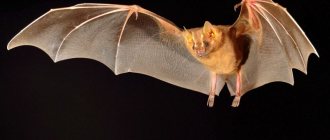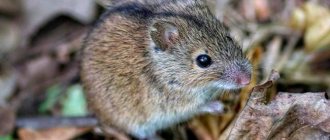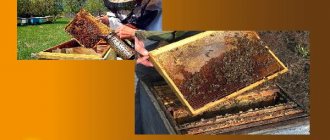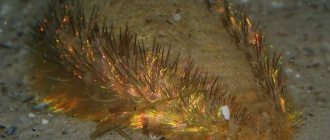How favorable the winter will be for the mouse depends on whether it was able to find suitable housing with a sufficient supply of food in the fall. The ideal option is a warm human home, a cellar, a barn or a room for keeping animals.
Under natural conditions, rodents have to independently take care of their own survival during the cold season.
Does a mouse sleep in winter or not?
Mice do not hibernate and are active all year round. In summer they are mostly crepuscular and nocturnal. With the onset of cold weather, the regime changes and you can see a rodent at any time of the day. Having found a comfortable place to live, they can also reproduce.
The question of whether mice sleep in winter seems relevant because they do not go out onto the snow cover, preferring to build tunnels inside it if necessary.
Outside the city, you can sometimes see an image of a cat, dog or fox suddenly starting to rake away a snowdrift. Most likely, they smelled a mouse.
Features of behavior
Voles are quite active living creatures, as their metabolic process is quite fast. They need to eat quite often, as they use up their energy quite quickly. Mice have a hard time withstanding hunger, and even more so lack of water. Without food and water, a vole mouse can live no more than 1 week.
Despite such facts, the vole mouse adapts quite quickly to new conditions. Rodents move in certain ways, and they mark their territory with urine. They show their main activity when it gets dark. Under certain conditions, rodents become more active during the day.
Mice are quite cautious living creatures. They react to the slightest sound or rustle, quickly running away to their shelter. This indicates that rodents have many natural enemies and danger lurks at every turn.
The pest tries to constantly stay as close to its hole as possible, moving away from it only a few meters. As a rule, rodents move in tall grass, under bushes or in the shade. Each individual has its own territory marked. They prefer to live in flocks, controlled by dominant males and females.
Interesting to know! The lifespan of individuals in natural conditions is no more than 1 year, although scientists believe that mice can live up to 7 years. The thing is that mice have many natural enemies. In artificial conditions, the average age of rodents is about 3 years.
Wintering for mice
Rodents begin to prepare for the cold early, as they have a lot of work to do. These animals can incomprehensibly predict what winter will be like.
People have long noticed that if rodents begin to appear en masse in the house and outbuildings in the fall, severe frosts await them.
In warm years, voles can build nests in haystacks or dig burrows to a depth of 1 to 3 meters. And if summer housing options for these rodents have a more complex layout, then winter ones are noticeably simpler. Everything here is very well thought out though.
Branched passages lead to a nest in which offspring will be born, to rooms with food supplies, and to an exit to water. To insulate the home, animal wool or fluff collected from bushes, moss, and dry grass is used.
If living conditions become completely unfavorable, mice can go into a kind of hibernation, but this state does not last long, since their metabolism is not designed for a long period of feeding on subcutaneous fat.
Natural enemies
When the mouse population decreases, the number of owls and foxes living in the same territory may also decrease. It is voles that predominate in their diet. These rodents are large enough to feed, and when a nest or hole is discovered, the predator gets a lot of food. Owls are also nocturnal and, thanks to their unique hearing aid, can detect the slightest movement of a rodent several tens of meters away. Scientists suggest that these large birds are able to discern even the shine of voles' eyes even in the dark.
Domestic cats will not disdain to snack on mice either. It is not without reason that when traces of voles were discovered in barns, they resorted to their help. Cats are considered better mouse catchers than cats. But there are no statistical data on this matter.
Voles are ideal as pets - they are cute, playful, and live up to 7 years, just like guinea pigs. You can feed mice with grain mixtures, young fresh plants, and thin cut tree branches. But voles pose a threat to agriculture, destroying vast areas of cereal crops and root crops.
How is wintering for a mouse?
Wintering conditions for rodents depend on the living conditions of their mouse species. For example, the life of a house mouse in the cold season is noticeably different for the better from the existence of a vole.
This is especially true for those years when frosts last for a long time.
voles
Snow saves a vole in winter in natural conditions. Under its cover, the cold does not feel so bad, and a deep hole usually allows you to wait for low temperatures in a comfortable environment without returning to the surface.
Problems arise when food supplies suddenly run out.
For example, in the fall, for some reason I had to leave my home due to a natural disaster. Therefore, they strive to become closer to humans. There is always something to profit from in stables, livestock buildings, and vegetable shops.
In extreme cases, tree bark and bush branches will help mice survive the winter. But for rodents this will be a difficult ordeal.
Pet rats
The habits of animals that have settled near people are noticeably different from the habits of their wild counterparts. The main difference is that house mice, unlike voles, do not need to fill their bins for the winter.
Usually they make do with a small supply for a while to feed their offspring.
Nests are created under the floor, in wall insulation, in basements and attics. In summer, and especially in winter, people are the main food suppliers.
In the city, these rodents feed on waste from garbage chutes and garbage cans. When they enter the apartment, they will not ignore cereals, meat products, and animal feed.
By establishing a home near a food source, they will not be subject to seasonal fluctuations and are ready to breed year-round.
What does it eat?
What are the food preferences of a rodent, since it chews literally everything that comes its way? He is capable of even such addictions that are difficult to even imagine. They chew holes in wooden, concrete or brick structures. Their diet includes products made from foam, plastic or rubber, as well as products from other synthetic materials.
It is not difficult to assume that such interest is associated with the growth of the rodent’s front teeth. As food, mammals prefer grains, seeds and succulent parts of various plants, including young shoots, seedlings, vegetables and fruits. They often supplement their diet with worms, insects, eggs and chicks.
In a person’s home, the vole mouse spoils any food products, but does not disdain grain, bulk food products, vegetables, fruits, meat, lard, sausage, etc.
Interesting to know! The vole mouse stores for the winter if it is in the field, and during the winter it eats everything that it managed to collect during the warm period. As for other representatives of this family that were able to gain access to human reserves, they do not care about supplies for the winter. The rodent stores for itself for the winter food items that are edible. In this case, the amount of reserves depends on the size of the mink.
During the day, the mouse eats no more than 5 g of food and drinks up to 20 ml of liquid. Instead of water, rodents consume succulent parts of plants. Around mid-summer, the animal begins to make supplies for the winter.
Does winter sleep exist in mice?
Some mammals hibernate during periods of scarcity of food resources. The vast majority of this happens during the cold season. There are 3 types of such dreams:
- Sleep mode. At this time, all processes in the animal’s body slow down. Breathing becomes less frequent, body temperature drops slightly. Returning to a normal lifestyle occurs easily when external factors change.
- Numbness. With this type of sleep, there is no reaction to stimuli such as sound or touch. The animal's temperature drops to a critically low level. The process of exiting this state takes longer over time and is possible under favorable long-term conditions. For example, a prolonged thaw.
- Anabiosis. Metabolic processes in such a dream slow down by up to 40%. Life is supported by fat deposits. The animal may lose 30–40% of its weight by weight. This is the deepest sleep.
In winter, voles do not appear in any of these dreams. Their body requires constant nutrition, otherwise death occurs. Only for 2–3 days, under the most unfavorable weather conditions, the animal falls asleep in a kind of winter sleep.
Only recently have scientists managed to induce artificial numbness in rodents by influencing certain groups of neurons in the brain.
Photo and description of a water rat
The body length of adult individuals ranges from 16 to 22 cm, the tail length is 8-13 cm. Males weigh on average 263 g, and females - 232 g. For voles, these are quite large sizes.
Voles are similar in appearance to mice and rats, but have a number of distinctive features, including a flatter snout and a shorter tail. Water voles are also often confused with brown rats because they have similar habitats, almost identical coloration, and are skilled swimmers.
The color of the upper body of the water rat varies from brownish-brown with a golden tint to black-brown. The belly is the same color as the back, but somewhat lighter. Their coloration makes them difficult to distinguish in the dense vegetation they prefer.
The water vole's head and face are flatter and rounder, and its ears are much smaller than those of other rodents. The relatively short tail is covered with many small dark hairs, through which the scales are visible. The long claws on the feet are used for digging holes. The skin between the toes is slightly webbed, which makes it easier for the animal to swim through the water.
In the photo, a water vole is eating aquatic vegetation.
Both males and females have specific glands on the sides of their bodies that are used to mark territory.
Water voles have a typical rodent dentition and continuously growing cheek teeth
Wintering for mice - optimal places
The ideal winter home for any mouse would be a human home or outbuildings where there is access to food. Unfortunately, for this tribe, not all of its representatives manage to shelter so well during the cold season.
In nature, voles are attracted to winter crops, especially if the first shoots appeared before the frost. In such conditions, even with minimal supplies, animals do not starve.
Therefore, in the southern regions, offspring often appear in burrows where mice live in winter. In the northernmost regions, breeding is rare at this time of year.
Man and vole
Since ancient times, the rodent has been considered a pest and enemy of humans. Living near human homes and lands, mice cause serious damage to crops and supplies, and also carry various infections.
During the years of active reproduction, the vole significantly harms plants:
- gnaws roots, causing the death of the plant;
- eats root vegetables and melons;
- sharpens seeds and grain;
- chews the bark of young trees.
The vole destroys farmers' plant products not only in the fields, but also in storage areas. It’s easy to understand that field mice have settled in the area and find out where they live: the pests give themselves away with typical traces of digging holes on the surface of the earth.
A mouse can be a carrier of very terrible diseases that can kill a person. Creatures that just look cute are, in large numbers, capable of causing:
- erysipelas infections;
- typhus;
- toxoplasmosis;
- leptospirosis;
- salmonellosis;
- tularemia.
They have earned a bad reputation for being carriers of the plague in the regions of Transcaucasia.
Preparing for cold weather
Voles living in the wild have been preparing for winter since late summer. The first thing she does is expand the “sleeping place” (mink).
This is necessary to insulate the hole and add storage for winter supplies. Throughout the entire cold period, the mouse does not leave the hole. To insulate the bedroom, the rodent uses dry grass, moss, wool or fluff.
Transformations also affect the vole's body. The rodent's fur changes color and becomes thicker.
The body gradually accumulates nutrients and fats. During winter frosts, the body temperature of a mouse can drop to levels like that of an icicle, but the animal survives.
The mouse fills the pantries with a variety of food for the winter (grains, seeds, dried fruits or grass). There have been cases when up to 5 kg of grain was found in mouse holes.
Often, with the onset of cold weather, people find uninvited guests in their homes. This is usually done by those individuals who are too lazy to prepare for winter; they look for easy ways.
What animals store food for the winter?
Some of our smaller brothers are inherently thrifty, especially when it comes to the cold season. Here are some animals that store food for the winter.
Chipmunk stores acorns and nuts in his pantry.
Bees leave sealed honey in the combs.
It leaves reserves of protein in various secluded places.
The hamster carries grain in his cheek pouches into his pantry all summer.
The badger sleeps most of the winter, but when it wakes up, it begins to eat its reserves.
In mouse holes they find up to 5 kg of grain, which they store for the cold season.
The mole also devotes part of his dungeon to storing food for the winter.
The beaver also drags small branches into its home, which will feed it in the winter.
The gopher lays down grain and grass seeds in its hole.
The pika carries seeds, grains and grass into its hole so as not to starve under the snow.
These animals are so scrupulous in matters of preparation that even some people can learn this from them.
Some of our smaller brothers are inherently thrifty, especially when it comes to the cold season. Here are some animals that store food for the winter. Chipmunk stores acorns and nuts in his pantry. Bees leave sealed honey in the combs. It leaves reserves of protein in various secluded places. The hamster carries grain in his cheek pouches all summer into his pantry. Badger […]
Chipmunk stores acorns and nuts in his pantry.
Bees leave sealed honey in the combs.
It leaves reserves of protein in various secluded places.
The hamster carries grain in his cheek pouches into his pantry all summer.
The badger sleeps most of the winter, but when it wakes up, it begins to eat its reserves.
In mouse holes they find up to 5 kg of grain, which they store for the cold season.
The mole also devotes part of his dungeon to storing food for the winter.
The beaver also drags small branches into its home, which will feed it in the winter.
The gopher lays down grain and grass seeds in its hole.
Spreading
The habitat of the field mouse is divided into two large parts, located in the Palearctic region. The western population occupies a temperate climate zone on the European continent up to the Balkans and the northern regions of Italy, while the Asian population is widespread in Russia, Mongolia, Korea and China.
Representatives of this species settle mainly in open and damp areas with an abundance of herbaceous vegetation. They can be found on the borders of forests, woodlands, meadows, bushes and reed thickets.
Very often they choose cultivated fields, orchards and vegetable gardens for their residence. They especially like farmland with cereal crops.
Tired of fighting pests?
Are there cockroaches, mice or other pests in your dacha or apartment? We need to fight them! They are carriers of serious diseases: salmonellosis, rabies.
Many summer residents are faced with pests that destroy crops and damage plants.
In such cases, our readers recommend using the latest invention - the Pest Reject repeller
.
It has the following properties:
- Gets rid of mosquitoes, cockroaches, rodents, ants, bedbugs
- Safe for children and pets
- Powered by mains, no recharging required
- There is no addictive effect in pests
- Large area of operation of the device
Voles are often confused with other mammalian rodents - the ground rat and the mole vole, and other species of voles.
For identification please note:
- color may vary depending on habitat;
- a characteristic stripe is laid along the back;
- differs from mice in the size of the body - the latter are smaller;
- the Udaur hamster has a shorter tail;
- in pieds, reproductive function starts earlier;
- the field mouse has a poorly developed auricle;
- Voles have rough fur that sometimes resembles hedgehog spines;
- field mice are quite mobile and can change their habitat several times during the season;
- can build nests in swamps.
Good to know
! Among its fellows, the field mouse differs in the color of its coat and some features of its existence.
Distribution of animals
This representative of the fauna is widespread in Europe. Animals can also be found in China, Mongolia, Denmark, Finland, Korea, and Taiwan. In the Russian Federation, the rodent is distributed in Primorye, Siberia, and the Urals. Often settles on the hills, climbs low into the mountains.
Found near the Black and Azov Seas. Does not like deserted forest-steppes and continuous forests. It takes root well in moist interfluves.
It prefers overgrown meadows with small depressions, collective farm fields, sunny edges of deciduous forests and, of course, vegetable gardens. It can be found in greenhouses, greenhouses, cellars, barns, abandoned utility sheds and even in residential premises.
IMPORTANT! With the onset of autumn, rodents move into stacks, haystacks, and stacks of straw.
